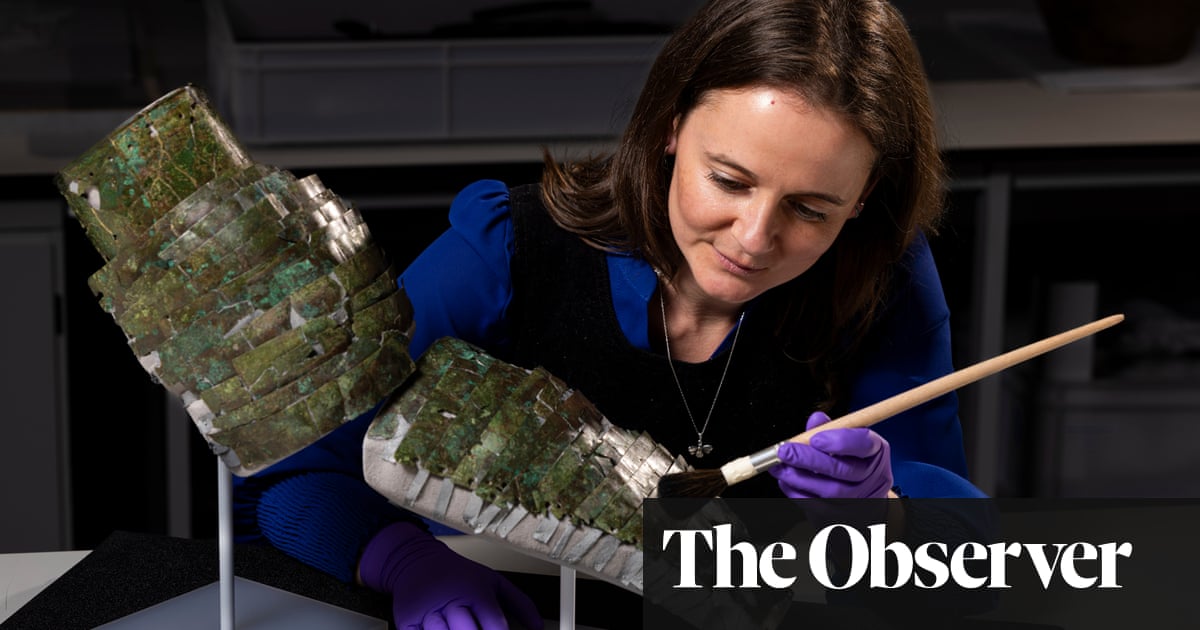
A magnificent brass arm guard, dating back 1,800 years, has been reconstructed using over 100 fragments discovered at Trimontium, a Roman fort in Scotland, believed to have been used by a distinguished soldier.
The remarkable puzzle of the arm-guard has been solved by National Museums Scotland (NMS) located in Edinburgh. It will be loaned to the British Museum’s upcoming display about life in the Roman army.
Crafted during the second century, this object features brass strips that overlap in a manner similar to the scales of an armadillo. It is one of only three of its kind from the entire Roman Empire and is considered the most well-preserved.
Although many arm-guards were constructed from iron for practicality, brass would have appeared more luxurious on the wearer’s arm and indicated a soldier’s position in battle.
Dr Fraser Hunter, the NMS’s principal curator of prehistory and Roman archaeology, told the Observer: “It’s absolutely amazing. You get the sense of the protection this person had – and also the prestige. It would have gleamed gold and would have looked absolutely spectacular when he was wearing it.”
In 1906, James Curle, a lawyer and historian, found this object at the Trimontium fort in Newstead, located in the Scottish Borders. He believed it was a protective piece for the chest and shoulders, but he could not find any similar items. In the 1990s, it was recognized as an arm-guard, but it has only recently been reconstructed.
Hunter stated that while working on the fragments, he came to the realization that they possessed the entirety of the piece. He added that the British Museum exhibit served as the catalyst for allowing them the necessary time and resources to assemble all the components.
This is likely a significant component of a soldier’s equipment, according to his belief: “We are aware that there were soldiers stationed at the garrison during that time. Due to its prestige – and the fact that brass was a costly material at the time – it is likely that this was owned by a high-ranking centurion.”
He stated that the adjusted design would have redirected any attack, with the majority of the impact absorbed by the padding underneath: “Your dominant arm was fully shielded.”
In approximately 180AD, the Romans encountered turmoil and disturbance in Scotland. There is a written account of barbarians attacking a general and his soldiers.
Although the fragments in NMS’s collection have been there for over 100 years, one of them has been exhibited for 25 years and another was temporarily loaned to the Trimontium Museum. Other pieces from it were kept in storage.
According to Bethan Bryan, the conservator for the NMS, completing the jigsaw puzzle was “a difficult task and a project that was done with great passion”.
Ignore the advertisement for the newsletter.
after newsletter promotion
It required approximately three weeks to finish and at times appeared unattainable due to the minuscule size of some of the pieces. Bryan stated, “Examining the same objects for three weeks can strain your vision and mind.” Nevertheless, every single fragment was successfully put into its designated spot.
The metal is well-preserved, and the patterns of corrosion provide insight into where the leather and padding were once attached. Some pieces of the original leather still remain.
The arm-guard was likely abandoned along with the rest of Trimontium when the Romans left. At its peak, the population of the area and its surrounding settlement would have been around 2,000 people.
The arm-guard was stored in the main building of the newest fort on the site. Hunter clarified, “This is where the commanding officer would brief their officers. It also appears to have been used as a workshop for fixing military gear. When the building was left behind, any excess equipment was simply discarded.”
Source: theguardian.com


















